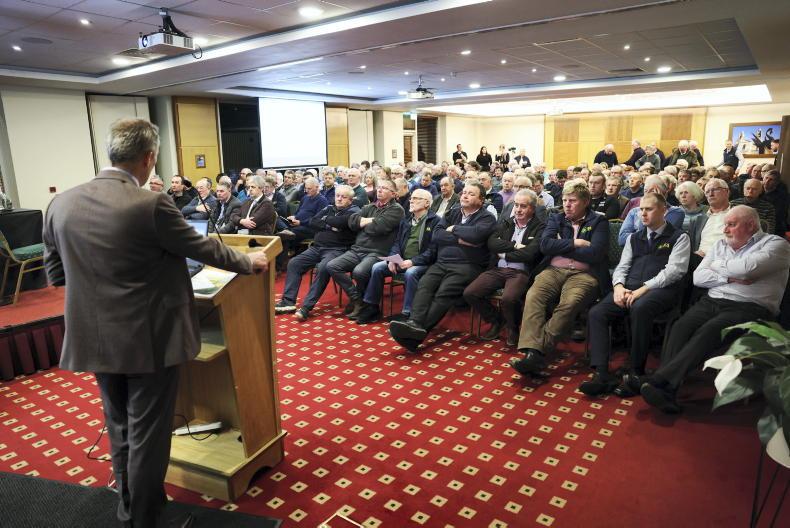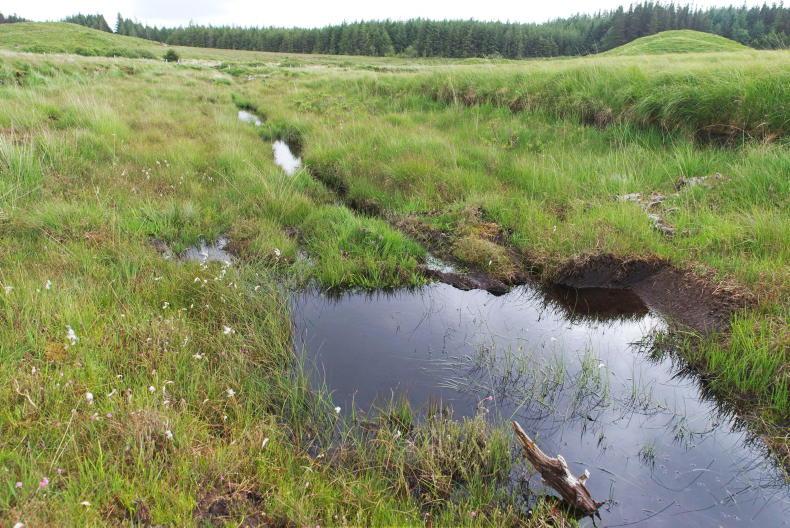The issue of Good Environmental and Agricultural Condition 2 (GAEC 2), a regulation aimed at protecting carbon-rich soils, has come to a head in recent weeks. Protests, public meetings and press statements are swirling. But amid the noise, one thing stands out for me: leadership, at all levels, is letting farmers down.
I don’t envy those in farm leadership roles. Representing this diverse community in the face of enormous technical, socioeconomic and environmental challenges is near impossible. However, I believe the consistent failure to engage with honesty and clarity is doing more harm than good.
GAEC2 is undoubtedly a sensitive issue and cuts to the core of landowners’ sense of independence and ability to improve their lot. Keeping land in good productive order is the bread and butter of farming.
The act of land reclamation, ie pulling land out of a wild or unproductive state, goes a step further. In farming circles, it is still viewed as a very righteous act, the embodiment of the old mantra “one more cow, one more sow, one more acre under the plough”.
These are the reasons GAEC2 is ringing alarm bells.
The practical implications of the regulation are complex and not widely understood. Farmers on marginal land fear they may lose their ability to improve their land. Farms that have already improved land fear they will not be able to maintain their current levels of intensity.
To the best of my knowledge, farmers have not yet been provided with the maps outlining the GAEC 2 areas on their holdings.
Adding to the confusion is the sensationalist framing put forward in parts of the farming media – “land grab”, “rewetting by stealth”, “plan to cut farming on 80,000ha”.
Practical, effective pilots on organic soil management such as FARMpeat EIP, FarmCarbon EIP, WANlife ) are out there, but they’re not making the headlines.
Why do we need GAEC 2?
The need to protect and restore organic soils is clear. These soils store over half of Ireland’s total soil carbon, even though they cover just one-fifth of our land area. When drained or disturbed, they become major sources of carbon, releasing anywhere between 2t/ha and 20t/ha per year.
Wetlands have faced the most radical losses of all our land types. Between 1994 and 2022, they shrank from 18.8% to 17.2% of the total land area. That’s the loss of over 277,000ac of vital carbon sinks and biodiversity refuges.
The lobbying on GAEC 2 has been ferocious. The IFA claimed credit for stalling its implementation in 2023 and 2024 through sustained lobbying, but in recent weeks has criticised the Government for “springing” the measures on farmers at the last minute.
This attempt to frame the situation as an unjust surprise, despite years of involvement in the process, feels disingenuous. A cynic might see it as an attempt to shift blame onto the Government while shielding themselves from criticism. Of course, as a democratic organisation, the IFA is beholden to represent the views of its members, but as former National Farmers’ Union head Minette Batters once said: “There’s a difference between farm representation and farm leadership.”
Real leadership means integrating the views of members with the unavoidable realities of our future.

Farmers gathered at the IFA peat soils meeting at the Hodson Bay Hotel in Athlone in March. \ Philip Doyle
Minister’s folly
The issue of GAEC 2 came back on the table in January when Minister for Agriculture Martin Heydon, under pressure from the European Commission, moved to finally implement it.
The messaging which accompanied the decision to implement is what caused me to raise an eyebrow. To me it sounded like ‘Europe is making us do this, but don’t worry, we won’t actually enforce it’.
The minister claimed that farmers would be unaffected by the change and that, at any rate, the inspection would be less than 1% and done online. This is reckless. Indicating to farmers that they won’t need to change and that rules won’t be enforced undermines the authority of the State, weakens accountability, and sends the message that rules are optional.
The foundation of our system is that laws apply equally to everyone and that they will be enforced consistently. We can’t expect farmers to respect regulations if the Government signals that they don’t really matter.
Ray Ó Foghlú is an environmental scientist and woodland conservationist He is the farm programmes co-ordinator with the Hometree charity.

The INHFA protested at Agriculture House in Dublin against the GAEC 2 rules, demanding fairer policies for rural Ireland. \ Justin Lynch
Agriculture is undergoing significant changes and there are more on the horizon. I believe most farmers are up for the challenge.
Nobody could blame them for being suspicious of new regulations or obligations. The State has not shown itself to be a reliable partner in previous periods of regulatory transition.
I feel sorry for them, the majority of whom are part-time, trying to make sense of it all. In a vacuum of knowledge and trust, they need, more than anything, clear information and a concrete plan of action. Instead, they’re given mixed messages and false promises. Those in leadership positions could be forgiven for not having all the answers during this time of rapid change and uncertainty. However, the approach taken by the minister and farm representatives begs the question: have we learned nothing?
It’s barely a year since the nitrogen derogation crisis, when farm organisations insisted its loss was inconceivable, long after banks had stopped lending at 250kg N org/ha. Instead of facing reality and preparing for change, heads were buried in the sand until it became a full-blown crisis.
GAEC 2 is just the latest such hurdle on the road to a future where food production and the rural economy must be balanced with environmental sustainability. If the State and farming bodies continue to dodge hard decisions and mislead farmers at such critical moments, the long-term damage to both farming and the environment will far outweigh any short-term political fallout.
The issue of Good Environmental and Agricultural Condition 2 (GAEC 2), a regulation aimed at protecting carbon-rich soils, has come to a head in recent weeks. Protests, public meetings and press statements are swirling. But amid the noise, one thing stands out for me: leadership, at all levels, is letting farmers down.
I don’t envy those in farm leadership roles. Representing this diverse community in the face of enormous technical, socioeconomic and environmental challenges is near impossible. However, I believe the consistent failure to engage with honesty and clarity is doing more harm than good.
GAEC2 is undoubtedly a sensitive issue and cuts to the core of landowners’ sense of independence and ability to improve their lot. Keeping land in good productive order is the bread and butter of farming.
The act of land reclamation, ie pulling land out of a wild or unproductive state, goes a step further. In farming circles, it is still viewed as a very righteous act, the embodiment of the old mantra “one more cow, one more sow, one more acre under the plough”.
These are the reasons GAEC2 is ringing alarm bells.
The practical implications of the regulation are complex and not widely understood. Farmers on marginal land fear they may lose their ability to improve their land. Farms that have already improved land fear they will not be able to maintain their current levels of intensity.
To the best of my knowledge, farmers have not yet been provided with the maps outlining the GAEC 2 areas on their holdings.
Adding to the confusion is the sensationalist framing put forward in parts of the farming media – “land grab”, “rewetting by stealth”, “plan to cut farming on 80,000ha”.
Practical, effective pilots on organic soil management such as FARMpeat EIP, FarmCarbon EIP, WANlife ) are out there, but they’re not making the headlines.
Why do we need GAEC 2?
The need to protect and restore organic soils is clear. These soils store over half of Ireland’s total soil carbon, even though they cover just one-fifth of our land area. When drained or disturbed, they become major sources of carbon, releasing anywhere between 2t/ha and 20t/ha per year.
Wetlands have faced the most radical losses of all our land types. Between 1994 and 2022, they shrank from 18.8% to 17.2% of the total land area. That’s the loss of over 277,000ac of vital carbon sinks and biodiversity refuges.
The lobbying on GAEC 2 has been ferocious. The IFA claimed credit for stalling its implementation in 2023 and 2024 through sustained lobbying, but in recent weeks has criticised the Government for “springing” the measures on farmers at the last minute.
This attempt to frame the situation as an unjust surprise, despite years of involvement in the process, feels disingenuous. A cynic might see it as an attempt to shift blame onto the Government while shielding themselves from criticism. Of course, as a democratic organisation, the IFA is beholden to represent the views of its members, but as former National Farmers’ Union head Minette Batters once said: “There’s a difference between farm representation and farm leadership.”
Real leadership means integrating the views of members with the unavoidable realities of our future.

Farmers gathered at the IFA peat soils meeting at the Hodson Bay Hotel in Athlone in March. \ Philip Doyle
Minister’s folly
The issue of GAEC 2 came back on the table in January when Minister for Agriculture Martin Heydon, under pressure from the European Commission, moved to finally implement it.
The messaging which accompanied the decision to implement is what caused me to raise an eyebrow. To me it sounded like ‘Europe is making us do this, but don’t worry, we won’t actually enforce it’.
The minister claimed that farmers would be unaffected by the change and that, at any rate, the inspection would be less than 1% and done online. This is reckless. Indicating to farmers that they won’t need to change and that rules won’t be enforced undermines the authority of the State, weakens accountability, and sends the message that rules are optional.
The foundation of our system is that laws apply equally to everyone and that they will be enforced consistently. We can’t expect farmers to respect regulations if the Government signals that they don’t really matter.
Ray Ó Foghlú is an environmental scientist and woodland conservationist He is the farm programmes co-ordinator with the Hometree charity.

The INHFA protested at Agriculture House in Dublin against the GAEC 2 rules, demanding fairer policies for rural Ireland. \ Justin Lynch
Agriculture is undergoing significant changes and there are more on the horizon. I believe most farmers are up for the challenge.
Nobody could blame them for being suspicious of new regulations or obligations. The State has not shown itself to be a reliable partner in previous periods of regulatory transition.
I feel sorry for them, the majority of whom are part-time, trying to make sense of it all. In a vacuum of knowledge and trust, they need, more than anything, clear information and a concrete plan of action. Instead, they’re given mixed messages and false promises. Those in leadership positions could be forgiven for not having all the answers during this time of rapid change and uncertainty. However, the approach taken by the minister and farm representatives begs the question: have we learned nothing?
It’s barely a year since the nitrogen derogation crisis, when farm organisations insisted its loss was inconceivable, long after banks had stopped lending at 250kg N org/ha. Instead of facing reality and preparing for change, heads were buried in the sand until it became a full-blown crisis.
GAEC 2 is just the latest such hurdle on the road to a future where food production and the rural economy must be balanced with environmental sustainability. If the State and farming bodies continue to dodge hard decisions and mislead farmers at such critical moments, the long-term damage to both farming and the environment will far outweigh any short-term political fallout.











SHARING OPTIONS